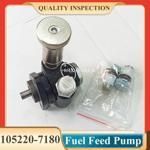Information injection-pump assembly
ZEXEL
101403-9040
1014039040
NISSAN-DIESEL
1670019D20
1670019d20
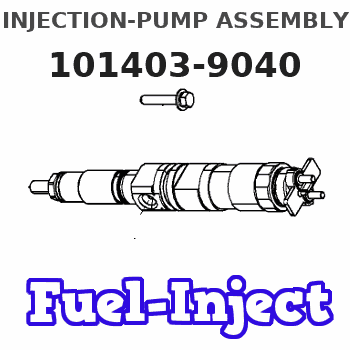
Rating:
Service parts 101403-9040 INJECTION-PUMP ASSEMBLY:
1.
_
6.
COUPLING PLATE
7.
COUPLING PLATE
8.
_
9.
_
11.
Nozzle and Holder
16600-19D20
12.
Open Pre:MPa(Kqf/cm2)
19.6{200}
15.
NOZZLE SET
Cross reference number
ZEXEL
101403-9040
1014039040
NISSAN-DIESEL
1670019D20
1670019d20
Zexel num
Bosch num
Firm num
Name
Calibration Data:
Adjustment conditions
Test oil
1404 Test oil ISO4113 or {SAEJ967d}
1404 Test oil ISO4113 or {SAEJ967d}
Test oil temperature
degC
40
40
45
Nozzle and nozzle holder
105780-8140
Bosch type code
EF8511/9A
Nozzle
105780-0000
Bosch type code
DN12SD12T
Nozzle holder
105780-2080
Bosch type code
EF8511/9
Opening pressure
MPa
17.2
Opening pressure
kgf/cm2
175
Injection pipe
Outer diameter - inner diameter - length (mm) mm 6-2-600
Outer diameter - inner diameter - length (mm) mm 6-2-600
Overflow valve
134424-4120
Overflow valve opening pressure
kPa
255
221
289
Overflow valve opening pressure
kgf/cm2
2.6
2.25
2.95
Tester oil delivery pressure
kPa
157
157
157
Tester oil delivery pressure
kgf/cm2
1.6
1.6
1.6
Direction of rotation (viewed from drive side)
Right R
Right R
Injection timing adjustment
Direction of rotation (viewed from drive side)
Right R
Right R
Injection order
1-3-4-2
Pre-stroke
mm
3.2
3.15
3.25
Rack position
Point A R=A
Point A R=A
Beginning of injection position
Drive side NO.1
Drive side NO.1
Difference between angles 1
Cal 1-3 deg. 90 89.5 90.5
Cal 1-3 deg. 90 89.5 90.5
Difference between angles 2
Cal 1-4 deg. 180 179.5 180.5
Cal 1-4 deg. 180 179.5 180.5
Difference between angles 3
Cyl.1-2 deg. 270 269.5 270.5
Cyl.1-2 deg. 270 269.5 270.5
Injection quantity adjustment
Adjusting point
-
Rack position
14.1
Pump speed
r/min
900
900
900
Average injection quantity
mm3/st.
98.5
96.9
100.1
Max. variation between cylinders
%
0
-3.5
3.5
Basic
*
Fixing the rack
*
Standard for adjustment of the maximum variation between cylinders
*
Injection quantity adjustment_02
Adjusting point
H
Rack position
9.7+-0.5
Pump speed
r/min
325
325
325
Average injection quantity
mm3/st.
10
8.2
11.8
Max. variation between cylinders
%
0
-10
10
Fixing the rack
*
Standard for adjustment of the maximum variation between cylinders
*
Injection quantity adjustment_03
Adjusting point
A
Rack position
R1(14.1)
Pump speed
r/min
900
900
900
Average injection quantity
mm3/st.
98.5
97.5
99.5
Basic
*
Fixing the lever
*
Boost pressure
kPa
65.3
65.3
Boost pressure
mmHg
490
490
Injection quantity adjustment_04
Adjusting point
B
Rack position
R1+0.95
Pump speed
r/min
1500
1500
1500
Average injection quantity
mm3/st.
111
107
115
Fixing the lever
*
Boost pressure
kPa
65.3
65.3
Boost pressure
mmHg
490
490
Boost compensator adjustment
Pump speed
r/min
500
500
500
Rack position
R2-1.2
Boost pressure
kPa
14.7
13.4
16
Boost pressure
mmHg
110
100
120
Boost compensator adjustment_02
Pump speed
r/min
500
500
500
Rack position
R2(R1)
Boost pressure
kPa
52
52
52
Boost pressure
mmHg
390
390
390
Timer adjustment
Pump speed
r/min
780--
Advance angle
deg.
0
0
0
Remarks
Start
Start
Timer adjustment_02
Pump speed
r/min
730
Advance angle
deg.
0.5
Timer adjustment_03
Pump speed
r/min
1550
Advance angle
deg.
5.7
5.2
6.2
Timer adjustment_04
Pump speed
r/min
-
Advance angle
deg.
7
6.5
7.5
Remarks
Measure the actual speed, stop
Measure the actual speed, stop
Test data Ex:
Governor adjustment
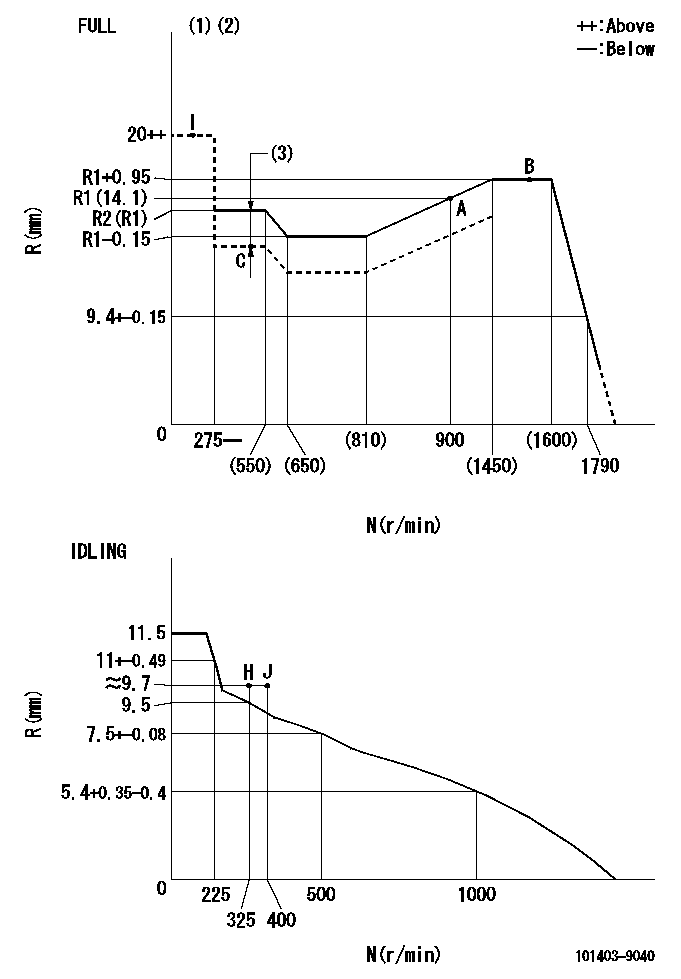
N:Pump speed
R:Rack position (mm)
(1)Torque cam stamping: T1
(2)Tolerance for racks not indicated: +-0.05mm.
(3)Boost compensator stroke: BCL
----------
T1=N48 BCL=1.2+-0.1mm
----------
----------
T1=N48 BCL=1.2+-0.1mm
----------
Speed control lever angle
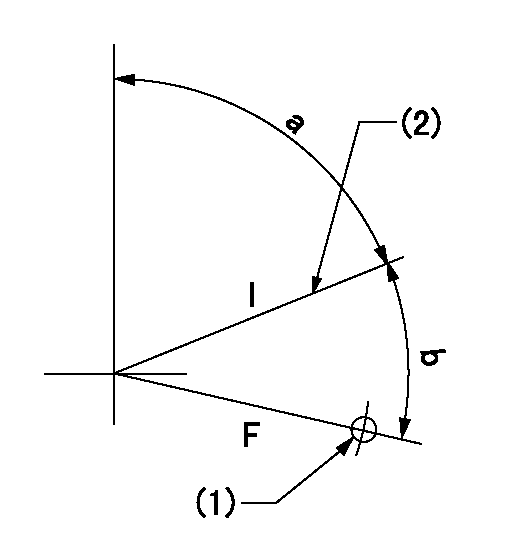
F:Full speed
I:Idle
(1)Use the hole at R = aa
(2)Stopper bolt set position 'H'
----------
aa=32mm
----------
a=71deg+-5deg b=41deg+-3deg
----------
aa=32mm
----------
a=71deg+-5deg b=41deg+-3deg
Stop lever angle
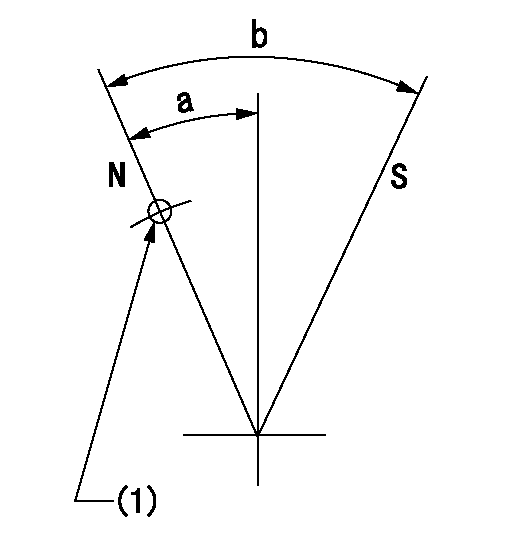
N:Pump normal
S:Stop the pump.
(1)Use the pin at R = aa
----------
aa=15mm
----------
a=10deg+-5deg b=29deg+-5deg
----------
aa=15mm
----------
a=10deg+-5deg b=29deg+-5deg
Timing setting

(1)Pump vertical direction
(2)Position of gear's standard threaded hole at No 1 cylinder's beginning of injection
(3)B.T.D.C.: aa
(4)-
----------
aa=8deg
----------
a=(50deg)
----------
aa=8deg
----------
a=(50deg)
Information:
Most commercial antifreezes are formulated for gasoline engine applications and will, therefore, have high silicate content. ASTM D4985 antifreeze is a low silicate antifreeze and should be used if not using Caterpillar Antifreeze. The percentage of antifreeze and water should be determined by the amount of freeze protection required. Follow the instructions provided by the antifreeze supplier.When using any antifreeze (except Caterpillar Antifreeze) supplemental coolant additive is required at initial fill. Caterpillar or other manufacturer's products can be used as the supplemental coolant additive.Add 1 liter (1 U.S. quart) of liquid supplemental coolant additive for every 15 liter (4 U.S. gallon) so that the cooling system will have a three to six percent concentration of supplemental coolant additive.DO NOT mix Caterpillar Supplemental Coolant Additive (Conditioner) or supplemental coolant additive elements with the other products available; select a cooling system treatment and use it exclusively. If other than Caterpillar products are used as the supplemental coolant additive, follow the manufacturers' recommendation for cooling system treatment and test evaluation.Supplemental Coolant Additive (Conditioner or Inhibitor)
Never use coolant in Caterpillar engines without supplemental coolant additive regardless of antifreeze concentration.Caterpillar or other manufacturer's products can be used as the supplemental coolant additive. DO NOT mix Caterpillar Supplemental Coolant Additive (Conditioner) liquid or elements with the other commercial products available; select a cooling system treatment and use it exclusively.Excessive concentration of supplemental coolant additive can form deposits which may cause engine damage, reduce the engine's heat transfer characteristics and could also accelerate water pump seal wear.
The cooling system MUST contain supplemental coolant additives (conditioner or inhibitor) to control corrosion, cavitation and deposits. It is also necessary to prevent rust, scale, pitting and/or corrosion of engine parts contacted by coolant. The cooling system should be protected with a minimum of three percent concentration at all times, regardless of the concentration of antifreeze. Use supplemental coolant additive liquid OR an element (if equipped) to maintain a three to six percent concentration in the cooling system.Use the 8T5296 Test Kit to check and monitor the SCA concentration for antifreeze/water coolant mixture. The Caterpillar 8T5296 Test Kit checks for concentration of nitrates in the coolant solution. Some other manufacturers' supplemental coolant additive (SCA) are phosphate based and the 8T5296 Test Kit will NOT provide accurate results. Caterpillar recommends that their test kit be used to check coolant solution concentration.If other than Caterpillar products are used as the supplemental coolant additive, follow the manufacturers' recommendation for cooling system treatment and test evaluation. Commercial supplemental coolant additive products must contain silicates and a minimum of 70 gr/U.S. gallon (1200 ppm) nitrites.Caterpillar liquid supplemental coolant additive (Conditioner) is available through your Caterpillar dealer in quantities that follow. Pre-chargeCaterpillar Antifreeze DOES NOT require supplemental coolant additive added at initial fill, however additive is required on a maintenance basis. For engines equipped with supplemental coolant additive elements, the last MAINTENANCE element should not be replaced at FLUSH & FILL or Overhaul until the next oil change interval. Corrosion in raw (sea) water
Never use coolant in Caterpillar engines without supplemental coolant additive regardless of antifreeze concentration.Caterpillar or other manufacturer's products can be used as the supplemental coolant additive. DO NOT mix Caterpillar Supplemental Coolant Additive (Conditioner) liquid or elements with the other commercial products available; select a cooling system treatment and use it exclusively.Excessive concentration of supplemental coolant additive can form deposits which may cause engine damage, reduce the engine's heat transfer characteristics and could also accelerate water pump seal wear.
The cooling system MUST contain supplemental coolant additives (conditioner or inhibitor) to control corrosion, cavitation and deposits. It is also necessary to prevent rust, scale, pitting and/or corrosion of engine parts contacted by coolant. The cooling system should be protected with a minimum of three percent concentration at all times, regardless of the concentration of antifreeze. Use supplemental coolant additive liquid OR an element (if equipped) to maintain a three to six percent concentration in the cooling system.Use the 8T5296 Test Kit to check and monitor the SCA concentration for antifreeze/water coolant mixture. The Caterpillar 8T5296 Test Kit checks for concentration of nitrates in the coolant solution. Some other manufacturers' supplemental coolant additive (SCA) are phosphate based and the 8T5296 Test Kit will NOT provide accurate results. Caterpillar recommends that their test kit be used to check coolant solution concentration.If other than Caterpillar products are used as the supplemental coolant additive, follow the manufacturers' recommendation for cooling system treatment and test evaluation. Commercial supplemental coolant additive products must contain silicates and a minimum of 70 gr/U.S. gallon (1200 ppm) nitrites.Caterpillar liquid supplemental coolant additive (Conditioner) is available through your Caterpillar dealer in quantities that follow. Pre-chargeCaterpillar Antifreeze DOES NOT require supplemental coolant additive added at initial fill, however additive is required on a maintenance basis. For engines equipped with supplemental coolant additive elements, the last MAINTENANCE element should not be replaced at FLUSH & FILL or Overhaul until the next oil change interval. Corrosion in raw (sea) water
